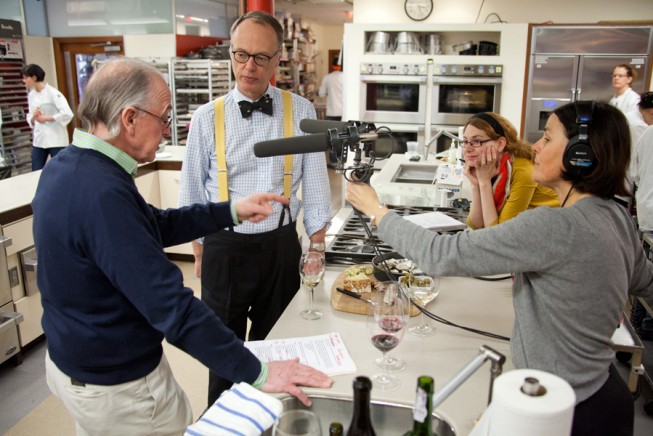
Often the variation that occurs in the same wine from one vintage to another is minor and limited to interesting variations on a theme. A cool spring…a drier than normal summer…a little too much rain in September…each can leave their imprint on a wine. But what happens when conditions are seriously bad?
You might think that there’s nothing much to be done when the weather just won’t cooperate—for example, when a late season hailstorm dramatically diminishes the crop or when rain during the harvest season dilutes the juice or engenders rot. In regions that experience these sorts of calamities, wine critics will suggest this is one vintage to just pass by.
It’s probably true that if you’re buying wine to impress your geek friends or with a view to collect or invest, then the quality and reputation of the vintage is an all important consideration. But from the winemaker’s perspective, the situation looks completely different. Except in a truly apocalyptic vintage, the man or woman whose living depends on cash received in exchange for finished wine can’t just shrug and walk away as critics, collectors, and consumers can. Given lemons, winemakers have to suck it up and do their best to make the wine equivalent of lemonade.
To understand this, let’s first explain what can turn a normal vintage into a problematic one.
Serious trouble typically means something going wrong at one of the key stages of the vine’s annual cycle—either when the buds first emerge from last year’s canes (when a late frost could kill them) or when flowering occurs (a metabolic deficiency called coulure may result in the flowers falling off before they can transition to fruit) or as harvest approaches and grapes make their final sprint to ripeness. At every stage, there’s a lot that can go wrong and plenty of opportunity for bad things to happen.
The main reason why for most of its history in northern Europe wine tended to be thin in body and with low in alcohol is simply that vintners, fearing late season disaster, picked as early as they possibly could. To leave fruit on the vine to ripen fully was to expose yourself—needlessly, it was thought—to the risk of loss.
Typically, adverse conditions result in one of three unhappy outcomes: (1) the harvest is much smaller than hoped for; (2) the harvest is abundant, but hasn’t ripened fully; (3) grapes are swelled with moisture with the result that the juice is not sufficiently concentrated.
Except in a truly apocalyptic vintage, the man or woman whose living depends on cash received in exchange for finished wine can’t just shrug and walk away.
To demonstrate the strategies skillful winemakers can legally resort to in dealing with a challenging vintage, I poured Chris one wine in a recent on air segment that I knew to be the result of some particularly fancy, and admirable, maneuvering. The wine is the 2013 Domaine St. Damien Vieilles Vignes Gigondas. Here is its story:
In 2013 France’s Rhone Valley struggled with wet, cool weather. In a normal year, St. Damien makes three distinct blends. Bear in mind that a quality producer with multiple vineyard sites will typically vinify them as separate lots, even if the same grape varietals are planted on them—and will keep them separate as they mature. He may then bottle each individually—perhaps with the name of the vineyard or site to distinguish it—or he may use the various vats of wine as a cook would ingredients and formulate proprietary blends marketed under different names.
In 2013, trouble began in the spring and never really let up. There was not enough quality fruit to make three separate blends—the solution: make a single blend using fruit from all three parcels and sell it under the property’s basic Gigondas label. Since two of these lots are normally earmarked for the what property considers its prestige blends, they convey extra doses of richness and concentration to the basic blend. In this case, the top labels are abandoned, and the least important one is the beneficiary. Since the consumers are paying only for the basic wine, they can be said to be getting a bonus.
Several other strategies are worth a mention. Having plots located in more than one area and with some variation in microclimate can provide a hedge from disaster, as can having multiple grape varieties with differing ripening schedules.
Also, in most European wine zones, producers are permitted to add up to about 20% of wine from vintages other than the one declared on the label from their reserve stocks. Normally, this would mean adding some wine from better vintages to boost a weaker one, but in some cases, it can work the other way. One winemaker recently explained to me how, knowing that he could not sell as much wine from a vintage the critics had panned, he reduced the amount he had to sell by siphoning off some amount of wine from the questionable vintage and adding it to less problematic ones. This can only work if he is not adding wine with a lower legal classification to wine with a higher one. In the worst possible scenario, when a winemaker calculates that there’s no way to make use of what he produced without damaging his reputation, he may just sell off lots to a broker who will find a buyer for it somewhere.
Clearly, it’s important for winemakers to have the skills to cope with troubles when they come. Knowing a bit about how they do it can help consumers find the silver lining in a vintage clouded by vicissitude.
Stephen Meuse can be reached at stephenmeuse@icloud.com